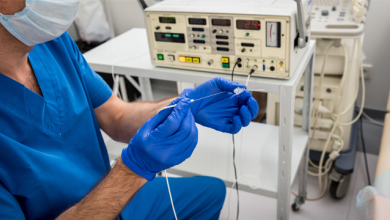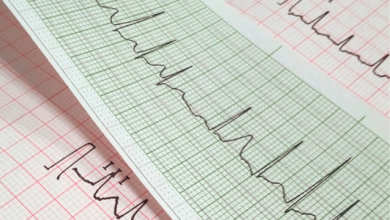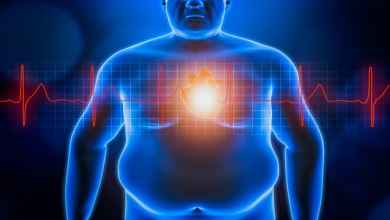Search results
Author(s):
Krystien VV Lieve
,
Arthur A Wilde
,
Christian van der Werf
Added:
3 years ago
Catecholaminergic polymorphic ventricular tachycardia (CPVT) is a rare but severe genetic cardiac arrhythmia disorder. Clinically, CPVT most often presents in childhood with symptoms such as syncope or sudden cardiac death due to polymorphic ventricular tachycardia (VT) or ventricular fibrillation typically triggered by exercise or emotions in the absence of structural heart disease.1
Mutations…
View more
Author(s):
Mohamed Abbas
,
Chris Miles
,
Elijah R Behr
Added:
1 year ago
Author(s):
Jeffrey J Hsu
,
Ali Nsair
,
Jamil A Aboulhosn
,
et al
Added:
3 years ago
Monomorphic ventricular arrhythmias (MMVA) are not uncommon in athletes,1,2 yet their presence appropriately raises concern among practitioners for possible increased risk of sudden cardiac death (SCD) during sports activity and competition. While all MMVA detected in athletes warrant further evaluation,1 a majority of MMVA in this population are likely to be benign. In some instances of so…
View more
Author(s):
Giulio Conte
,
Ulrich Schotten
,
Angelo Auricchio
Added:
3 years ago
The Risk of Atrial Arrhythmias in Inherited Primary Arrhythmia Syndromes
The inherited primary arrhythmia syndromes (IPAS) are a heterogeneous group of diseases caused by mutations in genes encoding for cardiac ion channels. People affected by one of these inherited diseases have no overt structural cardiac abnormalities but are at higher risk of sudden cardiac death due to the occurrence of…
View more
Author(s):
Jackson J Liang
,
Yasuhiro Shirai
,
Aung Lin
,
et al
Added:
3 years ago
Idiopathic ventricular arrhythmias (VAs) are comprised of ventricular premature depolarisations, non-sustained ventricular tachycardia (VT)and rarely sustained VT, and these typically occur in the absence of structural heart disease. In general, idiopathic VAs tend to have a benign prognosis, although a high burden of VAs can result in left ventricular (LV) systolic dysfunction and cardiomyopathy…
View more
Author(s):
Ryan Wallace
,
Hugh Calkins
Added:
3 years ago
Author(s):
Neil T Srinivasan
,
Richard Schilling
Added:
3 years ago
An estimated 180,000–300,000 sudden cardiac deaths (SCD) occur in the US annually.1,2 Worldwide, sudden and unexpected cardiac death is the most common cause of death,2 accounting for 17 million deaths every year with SCD accounting for 25% of these. The accepted definition of SCD is death that occurs within one hour of onset of symptoms in witnessed cases, and within 24 hours of last being seen…
View more
Author(s):
Gonca Suna
,
Greg J Mellor
Added:
4 months ago
Author(s):
A John Camm
,
Bernard J Gersh
,
Demosthenes G Katritsis
Added:
3 years ago
Inherited arrhythmias comprise a group of disorders with inherited susceptibility to arrhythmias and conduction disturbances due to mutations in genes mainly encoding the Na+, and K+ channels, and other arrhythmogenic mechanisms such as those linked to Ca++ transport (Table 1).1 The majority of heritable cardiomyopathies and channelopathies are associated with disease-susceptibility genes…
View more
Unmasking Adenosine
Author(s):
Gareth DK Matthews
,
Andrew Grace
Added:
3 years ago
Article















